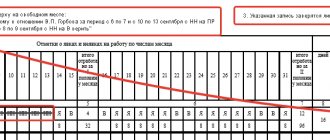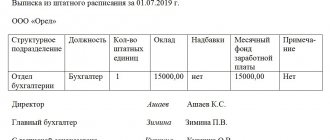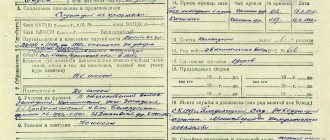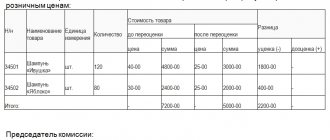Features and consequences of dismissing an employee retroactively
If the manager independently fired the employee retroactively, he may face administrative liability for violating the wording of making an entry in the work book, which is provided for in Art. 5.27 Code of Administrative Offenses of the Russian Federation.
Article 5.27 of the Code of Administrative Offenses of the Russian Federation
More precisely:
- Both legal entities and officials are held administratively liable.
- If the violation was committed by an official, the fine based on a court decision may range from 1 to 5 thousand rubles.
- If a violation of an employee’s rights is committed by a private small business entrepreneur without registering a legal entity, from 1 to 5 thousand rubles, the court may impose a temporary ban on the organization’s labor activities for up to three calendar months.
- If the offense was committed by a legal entity, the court may impose a fine of 30 to 50 thousand rubles and a temporary ban on working for up to three calendar months.
- For systematic violations of employees by the employer, he may incur administrative liability in the form of deprivation of the opportunity to carry out work activities for a period of one to three years.
An employee who is wrongfully retroactively terminated may:
- It must be remembered that under no circumstances should you submit a resignation letter under pressure from your employer.
- Also, you should not sign a dismissal order retroactively.
- It is best to start by contacting the trade union authorities or the labor dispute commission.
- If the employer refuses to comply with the instructions of the authorized bodies, it is worth filing a statement of claim in court.
- The employee has the right to directly go to court, where he cannot be denied the right to judicial review.
The time frame for challenging an issue is determined by the Labor Code of the Russian Federation, therefore, an employee has one month to appeal an unlawful dismissal.
Practice shows that in most cases the court makes a decision in favor of the employee, since retroactive dismissal is a direct offense.
Often, a court may rule to reinstate an employee; the dismissal of a reinstated employee may become grounds for bringing the employer to administrative liability.
Attention!
- Due to frequent changes in legislation, information sometimes becomes outdated faster than we can update it on the website.
- All cases are very individual and depend on many factors. Basic information does not guarantee a solution to your specific problems.
That's why FREE expert consultants work for you around the clock!
- via the form (below), or via online chat
- Call the hotline:
APPLICATIONS AND CALLS ARE ACCEPTED 24/7 and 7 days a week.
Often in organizations the question of retroactively dismissing an employee arises. The procedure in such cases is not considered by labor legislation. The employer must take into account all possible risks and carry out the procedure without violating the rights of participants in labor relations.
The employer, who is afraid of subsequent litigation, is always responsible for dismissal in violation of the Labor Code. Therefore, each situation is considered in compliance with the requirements of labor legislation.
Among the reasons for the impossibility of the procedure:
- Absence of a statement from the employee, written in his own hand and indicating the date.
- Lack of signature on the pay slip and work log book with a date after two weeks of work.
- Signature on the dismissal order.
Even dismissal by agreement of the parties can be challenged by the employee in court. In this case, the employer bears administrative responsibility and, based on a court decision, pays compensation to the employee.
We invite you to familiarize yourself with: Concept, contents and conditions of a bank deposit agreement
Organizations of any form of ownership sooner or later are faced with the preparation of documents on the dismissal of an employee. The ideal option to avoid consequences is to design with the current date. With a competent approach to the situation, it will be possible to avoid wage payments, compensation and court proceedings.
Own wish
There are situations when an employee does not come to work for several days without a good reason. He understands that an entry in the work book may interfere with his further employment. Then the employee comes to the manager with a question about whether it is possible to write a letter of resignation retroactively.
Most employers accommodate employees halfway and agree to violate labor laws. To resign retroactively at your own request:
- Days of absenteeism are documented as regular or administrative leave.
- The employee writes a letter of resignation on the required date, taking into account or without working hours.
- The HR department employee enters information into the order and work book on the same date.
When dismissing by agreement of the parties, the actual date of drawing up documents on termination of the contract is also indicated.
Not all employers know whether it is possible to retroactively fire an employee for absenteeism. This is possible, since unexplained absence from the workplace is a gross violation of discipline. In this case, the fact of absence must be documented in the form of an act or entry in the time sheet.
In case of retroactive dismissal for absenteeism:
- it is necessary to make an appropriate entry in the work book;
- issue an order, it is allowed to use the actual number of paperwork;
- The date of termination of the employment contract is considered to be the last working day when the employee was present at the workplace.
There is no need to rush when filing for dismissal for absenteeism. It is necessary to find out the true reason for the employee’s absence. He can issue a sick leave certificate, leave the city in connection with the funeral of a close relative, be unconscious in the hospital after an accident, and more.
When an employee does not come to work, does not answer phone calls, or the phone is turned off, it is necessary to draw up a report or reprimand regarding violation of internal regulations. It will allow you to suspend wages and formalize a temporary employment relationship with another person.
When search efforts do not produce results, the case is sent to court to declare the person missing. By decision of the court, the employer draws up documents for dismissal. If the wanted person is found and cannot provide proof of valid reasons, he is fired on the day of drawing up an act of violation of internal labor regulations.
The most unpleasant moment is filing a dismissal due to the death of an employee. The order is issued on the actual date on which the relatives provided the death certificate. In the work book, the date of termination of the employment contract is the date of death, and the reason is the certificate number. It is issued against the signature of a close relative for presentation at the place of request. This is the only situation where labor legislation allows retroactive dismissal.
For dismissal carried out in violation, the employer may be punished under Article 5.27 of the Code of Administrative Offenses of the Russian Federation. Among the forms of liability there are fines and restrictions on the activities of the organization.
A person who has incorrectly completed a work record book shall, by court decision, pay a fine in the amount of 1 to 5 thousand rubles. The same fate awaits representatives of small businesses. Additionally, they may be deprived of the right to work for up to 3 months.
In most cases, responsibility is placed on the manager, since it is he who signs the order, according to which the remaining documents are drawn up by the personnel department employees.
Employee actions
In case of wrongful dismissal, an employee loses part of his salary and days of service. In addition, the organization does not transfer contributions to social insurance funds and the tax office.
A wrongfully dismissed employee has 30 days to challenge the violation of labor laws. In court, decisions are often made in favor of the employee and oblige the employer to pay him compensation and cancel the termination of the contract. Not everyone will be able to continue working with this attitude from management, so the employee can quit after working 2 weeks after submitting the application.
| Dismissal | Retroactive dismissal
There are many situations when it is necessary to dismiss an employee retroactively; these circumstances do not always infringe on the rights of the parties to the employment contract, but such a provision is not provided for in the Labor Code of the Russian Federation.
Sometimes it is possible to get out of it and formalize such termination of the employment agreement, but it is worth remembering that there is always the possibility of a lawsuit being filed in court with a request to declare the dismissal unlawful and oblige the employer to pay compensation.
What does the law say?
In this case, it is not recommended to apply, since the reason for absence has not been established and may turn out to be valid. It is also possible that after clarification of the circumstances, the employee must be dismissed under a completely different article.
Action plan:
- First, you need to issue a reprimand to the employee for systematic violation of standards.
- From the moment a reprimand for absenteeism is issued, the employer has the right not to accrue wages and fees to the absent employee.
- You can hire another person to replace an employee on a temporary basis.
- Afterwards, you need to file a statement with the court asking that the employee be declared missing.
- If the search work does not yield anything, the employer has the right to terminate the contract by a court decision in accordance with Art. 83 Labor Code of the Russian Federation.
- If, nevertheless, an employee is found, and the reason for absence turns out to be unjustified, dismissal is formalized for absenteeism from the moment a severe reprimand is issued.
Is it possible?
- A handwritten letter from the employee is required two weeks before dismissal.
- After two weeks of work, the employee receives a work book and salary, he must sign in the journal, confirming that he received the documents and money in a timely manner, the entry is also dated.
- It is also signed by the employee on the day of dismissal after he has read the wording of the dismissal.
We invite you to familiarize yourself with: Termination of a trusteeship on the initiative of a shareholder, judicial practice
Evgenia KOZHANOVA, expert in general office work and archival affairs, manager (Samara)
Read in the article:
· How to discreetly retroactively register a document in an electronic journal
· When to leave a reserve for personnel orders
· What to do if rooms are booked but not used
Important personnel documents
The personnel officer often discovers an error in the numbering of orders, when, for example, No. 159 is immediately followed by No. 200. The opposite situation may also occur: you need to make an order retroactively, but there are no available numbers, and everything is written down in the journal in order. But the situation can be improved. The method depends on what kind of journal you keep - electronic or paper. In this article we will look at how to register documents retroactively as discreetly as possible and how to ensure that such situations arise as rarely as possible.
Method 1. Number orders within one day
Important article: “When is it better to transfer personnel records to branches rather than keep them at the head office” (No. 1, 2017)
An electronic journal allows you to relatively quietly register any number of documents per day. Relatively because some programs retain information about who, under what account, when and what changed the file. But this information can only be discovered by investigative authorities, and not by the State Inspectorate during an inspection.
The method will work if you number orders within one day. That is, assign a number to the order, which consists of: – the day code; – serial number of the document that was registered on that day.
For example, an order that a personnel officer registers on August 4 will have the number 04081, where 0408 is the fourth of August, and 1 is the serial number of the order that was registered first. On August 5 there will be a different day code 0508, and the second part of the registration code will start anew - from number 1. Such a system will allow you to register an order on a certain day in the electronic journal, even if the document was delivered late and the numbering has moved forward.
Example
Personnel officer Elena I. registers orders in an electronic journal on a certain day. On August 8, she needs to register three orders for August 4. To create additional rows, she highlighted the three rows below August 4th, right-clicked the highlighted area, and selected “paste.” Three new lines appeared in the journal. Elena wrote down orders on them numbered 0408004, 0508001, 0608001 (sample below).
The smart log of orders for personnel will automatically assign a document number. Don't forget to enable macros.
You can come up with your own options for how to designate the code of the day. It is permissible to place the day code in any sequence - before or after the document serial number, separated by a fraction or a hyphen. Fix your own numbering system in the office work instructions or issue a special order if there are no instructions (sample below).
Download and print the sample
Advantages. A numbering method that includes a day code and a serial number allows the correct number to be assigned to orders that should have been registered several days ago. No need to book rooms.
Flaws. This method is only suitable for electronic journals. You will have to change the numbering system, but only once.
Method 2. Cross out additional fields
In a logbook that you fill out manually, new blank lines will not appear just like that. You will have to cross out additional fields on the lines so that you can make a retroactive entry. In this regard, we recommend that you make sufficient indents between registered orders so that, if necessary, you can make another entry legibly.
Advantages. The numbering system remains the same. You can create new numbers for late documents using the usual method with the prefix “/a” or “/1”.
Flaws. With continuous sequential numbering No. 1, No. 2, No. 3, it is easier to detect documents that were created at the wrong time. They usually have a letter number, for example 124-a or a number with a slash 124/1. If a GIT inspector finds an order numbered 60/a during an inspection, he will make a comment about the incorrect numbering.
To prevent the inspector from finding fault, do not close the day with a letter number and a number with a slash. This will indirectly confirm that the document was actually registered later. It is better to place numbers with a letter or a slash in the middle of the day (sample below).
Click on to find out more
Live specimens
Why is such dismissal unlawful?
The Labor Code protects the rights of workers. Therefore, it does not allow them to be fired retroactively. This can only be done in rare cases. In other situations, the actions will be unlawful, since upon dismissal the following conditions must be met:
- upon dismissal at the employee's request, he must notify the employer 2 weeks in advance in writing;
- on the day of dismissal, the employee must receive his work book, and the accounting department must make all payments, including wages for time worked, compensation for vacation not taken;
- the order must be signed directly on the day of dismissal.
Moreover, if the issue can be resolved with an order and application, then with the transfer of funds - not. Most organizations transfer money to a card, that is, there is information about receipts. If desired, the former employee can go to court and receive compensation even on the basis of these transactions.
A person should be fired only in extreme cases and only if the employer is confident in his decency and honesty.
The procedure for issuing a certificate of incapacity for work retroactively
The procedure for issuing a sick leave certificate for people who were unable to seek help from doctors in time is similar to the standard procedure for visiting a medical facility:
- First of all, you need to make an appointment with your local doctor or a paid clinic for an initial examination. The only condition is that the medical institution has the appropriate license to issue ballots;
- Providing the doctor with a certificate or other document issued by a colleague, which proves that the patient’s illness began earlier. If such a document is not available, then the citizen should present a document proving the impossibility of visiting the clinic earlier;
- Examination by a representative of the medical institution of the presented document for authenticity; if no forgery is found, the patient will be issued a hospital bulletin with the date recorded on the originally presented document;
- Sending the received document to your employer or directly to the financial department of the organization for further receipt of benefits for the period of illness.
The document is reviewed, checked for authenticity and sent to the Social Insurance Fund within the next 10 days. The required material compensation, as a rule, is transferred on the date of the next payment of wages.
Retroactive dismissal - at one's own request, consequences, judicial practice - Center Pro
Situations when you need to fire an employee retroactively are quite common. No organization wants to be involved in litigation that can drag on for a long period of time.
The only drawback is that in this situation the manager will always be to blame, so if he wants to avoid lawsuits in the future, it is better to find legal grounds for dismissal and formalize the termination of the contract on the current date, even if this is much more troublesome.
After all, this kind of agreement can be characterized as an attempt to mislead a third party, since the actual date is distorted.
Is it possible?
How is it done? Find out from our article.
How to fire an employee for failure to perform official duties? Read.
Is it possible to register an order retroactively?
I think that if any litigation arises in which such an order appears, any court will pay attention to it. GOST R ISO 15489-1-2007 “System of standards for information, library and publishing. Document management. General requirements" establishes requirements for documents.
In accordance with this standard, the document must be authentic, reliable, complete, and suitable for use.
According to the standard: “a document is authentic if it: a) complies with established rules; b) was created or sent by a person authorized to do so; c) was created or sent at the time indicated in the document (emphasis added - V.Ya.). To ensure the authenticity of documents, organizations must implement and document policies and procedures for controlling the creation (emphasis added - V.Ya.), receipt, transmission, storage and
What could be the danger?
The law also provides for the consequences for the employer of such unlawful dismissal. They are spelled out in Article 5.27 of the Code of Administrative Offenses of the Russian Federation. It is noteworthy that not only the employer (organization), but also the official who formalized the dismissal is held liable. So, the consequences could be as follows:
- fine for an official – from 1 to 5 thousand rubles. (the same is provided for individual entrepreneurs);
- fine for the organization - from 30 to 50 thousand rubles, in addition the company may be required to stop work for up to 3 months;
- for systematic violations of labor legislation in relation to their employees - deprivation of the right to work for a period of 1 - 3 years.
Therefore, it makes sense to look for other solutions to the current situation. Retroactive dismissal should only be done as a last resort.
Sometimes an employee is dismissed without his consent at all. Then he can go to court to challenge the decision. Moreover, if there is evidence, the employee can:
- receive monetary compensation for material damage, calculated on the basis of the number of months after dismissal and the amount of wages;
- expect that the missed time will be included in his work experience, therefore, he will retain the right to leave;
- be restored to your previous position.
However, the former employee has only 1 month to challenge the decision after he was wrongfully fired. Afterwards the case will not be dealt with in court.
How to apply for backdated leave
When an agreement is reached with the manager or if there is confidence in a positive solution to the issue, the employee submits a retrospective application for rest .
It looks something like this: Download for viewing and printing: Sample application for leave at your own expense
The standard application contains the following information:
- employer and applicant information;
- number of calendar days of rest;
- exact vacation dates;
- date and signature of the applicant.
Attention! If the reason why the employee is forced to write an application for leave retroactively belongs to the category where the employer cannot refuse (his own wedding, death of loved ones, birth of a baby), then he indicates it.
Common grounds for such dismissal
- Your own desire - this is possible, you need a handwritten statement from the employee, dated by the required date. It is also necessary to date all dismissal documents to the same date.
- Agreement of the parties - in the event of retroactive termination of the employment contract by agreement, it is necessary to stipulate not only the desired date, but also to record the actual date of termination of cooperation at the time of drawing up the dismissal documents.
- The employer's initiative - an employee can be fired retroactively for absenteeism, if the fact of absenteeism was recorded in the staffing table. Absenteeism is a gross violation and a reason for dismissal at the initiative of the employer; the contract is terminated on the last day the employee visits the workplace, and an entry is made in the work book with the appropriate wording. If the employer simply notifies the employee that he is fired, and also retroactively, such an offense is the basis for a claim.
- Death of an employee - in this situation, a decree is issued to terminate the employment relationship on the actual date. But the work record book states that the employment relationship ceased on the date of the employee’s death. The grounds for dismissal are considered to be unforeseen circumstances; a record is made in the work book about the nature of the document that served as the reason for termination of the employment agreement - a death certificate.
Rules for document preparation
In any paperwork, documents are of key importance. Each of them goes through several stages - from filling out to entering into the archive. When an organization keeps records of a large number of documents, then the need arises to compile a register. Each document will be taken into account and displayed in this list. Employees of the organization will always be able to find it and use it in their future work.
Maintaining the register is determined by the laws of the Russian Federation “On the procedure for maintaining a register of documents for LLCs” and “On the register”. They describe what types of documents must be included in the company register, as well as the forms for their execution and storage.
The register greatly simplifies working with all documents of the organization, both incoming and outgoing. It includes a description of the documents, which allows the employee to find the one they need, as well as information about what is actually contained in it. This data will help determine to whom and when the document was issued.
Thus, we can highlight the main tasks of maintaining a register:
- Help with work and quick search for the document necessary for work;
- Accounting and storage of all available documentation;
- Issue upon request.
For quick searching, entries in the registry are kept in chronological order. If different people were involved in its registration and accounting at different periods of time, then the last column should indicate who made the last entry.
The register involves checking the documents that are subject to registration. Each is assigned an individual registration number, and detailed information about the employees who have ever worked on this document is entered there. Before entering a specific document into the register, it must be checked and determined whether it contains any violations.
Today, both novice entrepreneurs and large eminent organizations are involved in maintaining the register. This is due to its main advantage - searching for the required document takes a matter of minutes. A correctly executed register allows you to send a notification as quickly as possible, find the necessary document for work or for reporting (if required by the tax inspectorate). This takes the company's work to a new level. If, nevertheless, the organization does not maintain a register, then this fact will not be noted by the legislative bodies. The absence of a register does not entail a fine or other kind of punishment. This is more necessary for the company itself. Over many years of work, a large number of documents can accumulate, and if an employee of the supervisory department asks for one of them and does not receive it, then the entrepreneur may have big problems.
Consequences for the employer
Last modified: June 2019
The Labor Code is against performing any actions that have expired. A minimum amount of time is allocated for terminating an employment relationship - one day without limiting the maximum - up to several months, subject to an agreement reached by the parties.
Retroactive dismissal on legal grounds is possible only under the influence of force majeure circumstances, and the practical legitimization of an illegal operation due to technical errors is fraught with financial sanctions for the employer.
According to the letter of the law, is it possible to dismiss an employee retroactively? Such dismissal on a legal basis is permitted in the following cases:
- death of a citizen;
- recognition as missing by court decision.
Difficulties in severing relations arise for an employer when collaborating with persistent violators of labor discipline.
Even in the case of a long absence from the workplace, the administration, in order to obtain legal termination, is obliged to provide the right to an explanation to the “offending” employee or present an act of refusal to write an explanatory note drawn up by the commission. In the absence of documents, it is impossible to establish that the reason for absence from work is not valid.
Is it possible to fire someone for absenteeism retroactively when the circumstances are clarified? An erroneous understanding of the interpretation of Article 84.1 of the Labor Code of the Russian Federation, which considers the last day of cooperation to be the last working day, except in cases where the employee did not work with the right to retain his job, allows the employee to be dismissed on the date preceding the absence.
In fact, retroactive dismissal for absenteeism is impossible until the reasons are clarified. After all, on the date of absenteeism, the employee retained his job, and the employer did not take this fact into account when terminating the contract. Logically speaking, a citizen could have a valid reason for absence, about which the employer was in the dark. Then how can the unknown be classified as absenteeism?
Another common misconception is the desire to fire an employee for inadequacy for the position held. Termination of labor relations under paragraph 3 of Article 81 implies the conclusion of an attestation issued by a special commission within a specifically established time frame. What it means to be unsuitable for a position is determined by experts, not by the administration.
Although there is a Letter of the Federal Service for Labor and Employment No. 1074-6-1 dated June 11, 2006, which allows for retroactive dismissal for absenteeism on the day preceding the offense.
However, the document has a private clarification nature, given to the organization in response to a specifically formulated request.
This article was published on the website zakon-dostupno dot ru. If you see this article on another site, it has been stolen.
Despite the prohibition of labor legislation, in practice situations often arise when an employee is fired retroactively without warning.
An illegally dismissed citizen should go to court, where the employer will have to give an explanation and bear responsibility for a “bouquet” of consecutive unlawful actions:
- Absence of the initiator of termination of the contract. If it is an employer, then there is no fact of notifying the employee, and if it is an employee, then there is no notification in the form of an expressed desire. Here it is possible either groundless termination or falsification of the dismissal document retroactively by agreement of the parties or for another reason.
- Failure to comply with payment deadlines for the wage fund. At least on the last working day, the employee should have received a full payment of the current salary, including compensation for unused vacation.
- Failure to issue a work book. On the day of dismissal, the administration is obliged to personally hand over a completed work book or send a notice to the home address if the employee is absent from the place of performance of duties.
The employer will be subject to penalties for violating the deadlines for issuing wages in the form of compensation for each day of delay and payment of average earnings for the period of non-issuance of the work book.
Officials will be held administratively liable for violating labor laws, and additional liability will be imposed if falsification of documents is detected.
If desired, a citizen can be reinstated in his position and receive compensation for moral damage caused.
Sometimes situations arise when retroactive dismissal at one’s own request is truly the desire and request of the employee.
The employer can meet halfway if the relationship does not concern third parties and can be closed bilaterally. This is possible if the employee is on annual paid leave, the vacation pay received for which covers the mandatory payments upon dismissal.
We invite you to find out what year the privatization of apartments began
In practice, the following actions are performed:
- The employee writes a resignation letter retroactively, the date of which is the actual moment of receiving vacation pay.
- The personnel service replaces the vacation order with an order to terminate the contract; if there is no letter component in the numbering, even the number does not need to be changed.
- Accounting backwards calculates the current salary and the due compensation for unused vacation and compares it with the vacation pay issued. If:
- vacation pay issued exceeds the required termination payments, the difference is formalized as a bonus, financial assistance or severance pay;
- payments upon termination of the contract are higher in the monetary equivalent of vacation amounts, then the current salary is adjusted by reducing working hours or going on vacation at one’s own expense at the request of the employee.
- The “replayed” situation is carried out according to accounting, and the personnel department reflects the dismissal retroactively, the consequences of which will not be revealed during the audit.
If there is no settlement with the employee on the last day of work, the labor inspectorate will assess fines for non-compliance with labor legislation, automatically giving the fiscal service for personal income tax and social funds chances for financial sanctions on contributions for late receipt of payments to the budget.
If an employee wrote an application for leave for a week, and the accumulated compensation is several years old, then overplaying will not cover the compensation payments, and the accounting department will have to admit a “mistake.”
Retroactive dismissal is considered illegal by judicial practice and the Labor Code, except in cases of death and recognition as missing.
An enterprise may recognize long-term absenteeism by its own decision, referring to an individual consultation with the Federal authority, as grounds for dismissal from work in the expired period; in other cases, it is a “countdown” legalization of an illegal operation with possible consequences if detected.
Free question to a lawyer
[upto]
Often in organizations the question of retroactively dismissing an employee arises. The procedure in such cases is not considered by labor legislation. The employer must take into account all possible risks and carry out the procedure without violating the rights of participants in labor relations.
For dismissal carried out in violation, the employer may be punished under Article 5.27 of the Code of Administrative Offenses of the Russian Federation. Among the forms of liability there are fines and restrictions on the activities of the organization.
A person who has incorrectly completed a work record book shall, by court decision, pay a fine in the amount of 1 to 5 thousand rubles. The same fate awaits representatives of small businesses. Additionally, they may be deprived of the right to work for up to 3 months.
For legal entities, the fine ranges from 30 to 50 thousand rubles and a ban on work for up to 3 months. If it is proven in court that not one employee, but several, suffered from the employer’s unlawful actions, then the period of deprivation of the opportunity to work is set from 12 to 36 months.










